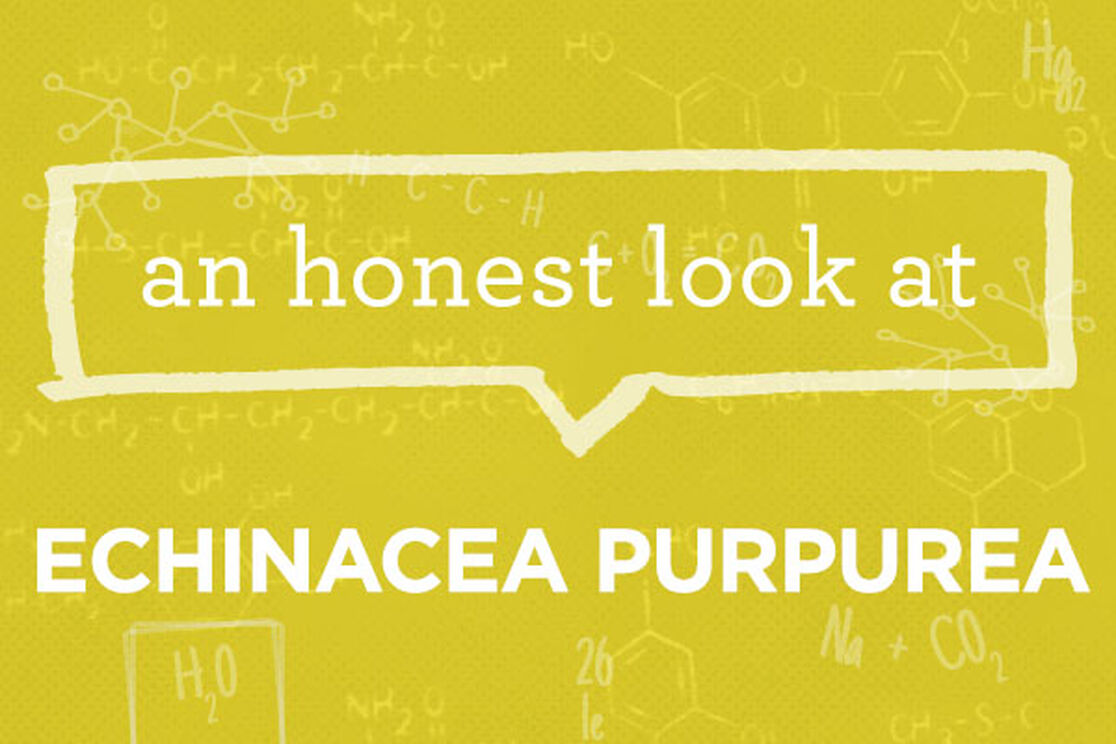This is part of our ongoing series helping consumers better understand chemicals, chemistry, and product formulations. We translate the science, bust the myths, and give you an honest assessment, so you can make informed choices for your family!
Ingredient:
Organic Echinacea Purpurea (Whole Plant) Powder Extract
What it is:
Echinacea Purpurea (aka purple coneflower) is a flower native to North America and is related to the daisy (1). It’s name comes from echinos, which is Greek for hedgehog, due to the resemblance between the spines of an angry hedgehog and the plant’s prickly, large conical seed head (1). The whole plant powder extract is exactly what it sounds like – the dried extract created by using all parts of the plant. ‘Organic’ means the flowers were grown without the use of toxic pesticides, synthetic fertilizers or sewage sludge (among other things).
What it does:
Echinacea purpurea has a long history of medicinal use for a variety of conditions, originally used by the Native Americans for over 400 hundred years (1). Today echinacea products are among the best-selling herbal preparations in many countries (2). Since 1930, over 300 studies have been published around the world verifying the effectiveness of echinacea with the broadest body of evidence demonstrating support for a healthy immune system† (2-8).
Why we use it:
With its long history of safe and effective immunity support, it was an obvious choice for our Immunity Plus – a delicious food or drink mix that’s great for the whole family!
References:
- Echinacea. (n.d.). Retrieved January 21, 2016, from https://umm.edu/health/medical/altmed/herb/echinacea
- Barnes, J., Anderson, L. A., Gibbons, S., & Phillipson, J. D. (2005). Echinacea species (Echinacea angustifolia (DC.) Hell., Echinacea pallida (Nutt.) Nutt., Echinacea purpurea (L.) Moench): a review of their chemistry, pharmacology and clinical properties. Journal of Pharmacy and Pharmacology, 57(8), 929-954.
- Conkling, W. (1999). Secrets of Echinacea. Macmillan.
- Spelman, K. (n.d.) Echinacea spp.: A Monograph & What’s New. American Herbalists Guild. Retrieved January 20, 2016, from http://www.americanherbalistsguild.com/sites/default/files/spelman_kevin_-_echinacea_update.pdf
- Lee, T. T., Huang, C. C., Shieh, X. H., Chen, C. L., Chen, L. J., & Yu, B. I. (2010). Flavonoid, phenol and polysaccharide contents of Echinacea purpurea L. and its immunostimulant capacity in vitro. IJESD, 1(1), 5-9.
- Perry, A. (2010). No Easy Answers to Echinacea's Evolution. Agricultural research, 58(3), 22.
- Woelkart, K., Marth, E., Suter, A., Schoop, R., Raggam, R. B., Koidl, C., ... & Bauer, R. (2006). Bioavailability and pharmacokinetics of Echinacea purpurea preparations and their interaction with the immune system.International journal of clinical pharmacology and therapeutics, 44(9), 401-408.
- Yamada, K., Hung, P., Park, T. K., Park, P. J., & Lim, B. O. (2011). A comparison of the immunostimulatory effects of the medicinal herbs Echinacea, Ashwagandha and Brahmi. Journal of ethnopharmacology,137(1), 231-235.

We aim to provide you with the most honest and credible information possible. This article was reviewed for accuracy by The Honest Team and was written based on sources that are linked at the bottom of the article.
blog_review_statement



